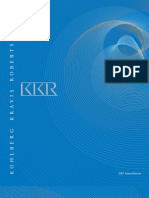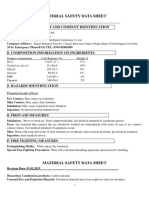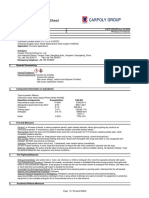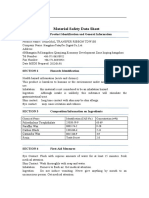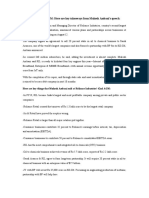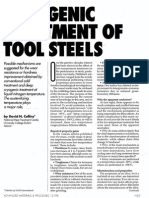0 ratings0% found this document useful (0 votes)
14 viewsMSDS Pa
MSDS Pa
Uploaded by
thaihien.saleThe document provides a material safety data sheet for PA/LLDPE plastic bags. It details the chemical composition and properties of the material. It also outlines safety guidelines for handling, storage, exposure, fire risks, accidental spills, and disposal of the material.
Copyright:
© All Rights Reserved
Available Formats
Download as PDF, TXT or read online from Scribd
MSDS Pa
MSDS Pa
Uploaded by
thaihien.sale0 ratings0% found this document useful (0 votes)
14 views3 pagesThe document provides a material safety data sheet for PA/LLDPE plastic bags. It details the chemical composition and properties of the material. It also outlines safety guidelines for handling, storage, exposure, fire risks, accidental spills, and disposal of the material.
Original Title
01. MSDS PA
Copyright
© © All Rights Reserved
Available Formats
PDF, TXT or read online from Scribd
Share this document
Did you find this document useful?
Is this content inappropriate?
The document provides a material safety data sheet for PA/LLDPE plastic bags. It details the chemical composition and properties of the material. It also outlines safety guidelines for handling, storage, exposure, fire risks, accidental spills, and disposal of the material.
Copyright:
© All Rights Reserved
Available Formats
Download as PDF, TXT or read online from Scribd
Download as pdf or txt
0 ratings0% found this document useful (0 votes)
14 views3 pagesMSDS Pa
MSDS Pa
Uploaded by
thaihien.saleThe document provides a material safety data sheet for PA/LLDPE plastic bags. It details the chemical composition and properties of the material. It also outlines safety guidelines for handling, storage, exposure, fire risks, accidental spills, and disposal of the material.
Copyright:
© All Rights Reserved
Available Formats
Download as PDF, TXT or read online from Scribd
Download as pdf or txt
You are on page 1of 3
MATERIAL SAFETY DATA SHEET
PA/LLDPE BAG MSDS
I. CHEMICAL PRODUCT AND COMPANY IDENTIFICATION
- Product Name : PA/LLDPE Bag Product code: PA/LLDPE
- Chemical Name : Polyamide / Linear Low
Density Polyethylene Plastic Bag
- Contact Information:
Hai Nam Co., Ltd
Address: Lot A25 – A26, Dien Phu Industrial
Park – Dien Khanh – Khanh Hoa – Viet Nam For non-emergency assistance, call:
- Intended use: packaging 84-2583-771-779
II. COMPOSITION AND INFORMATION ON INGREDIENTS
Name CAS # % by Weight
Polyethylene Resin - Butene Copolymer 25087-34-7 >59.5
Polyethylene Resin - Hexene Copolymer 25213-02-09 >20.5
Polyamide Resin 63428-84-2 >16.0
Additives, - <1.5
III. HAZARDS IDENTIFICATION
1. Hazard classification level: Not listed as malicious
2. Hazard warning:
- If dispersed in the form of dust, it may cause fire and explosion if mixed with some
components in the air
- In the form of melting, it can cause burns when exposed
- May produce poisonous gases when burning
3. Potential Acute Health Effects
- Eye contact: may cause eye irritation.
- Respiratory contact: may affect the respiratory tract if inhaled in the form of dust.
- Skin contact: may cause skin irritation, burns if exposed to molten state.
- Gastrointestinal contact: may cause gastrointestinal disturbance if swallowed.
IV. FIRST AID MEASURES
1. Eye contact: In case of contact with eyes, rinse thoroughly with water for several minutes,
remove contact lenses, if necessary, call a physician if necessary.
2. Skin contact: In the case of melting products in contact with the skin, remove the clothing
in the burn, wash it off with water (do not use ice), call the doctor.
3. Respiratory contact: In case of inhalation of large amounts of dusts, take victim to fresh
air and keep breathing well if victim show signs of apnea and call a physician.
V. FIRE AND EXPLOSION DATA
1. Flammability classification: Flammable
2. Products produced during combustion: CO, CO2, NO, NO2.
3. The agents causing fire and explosion: heat, sparks
4. Firefighting measures: Use fire fighting measures appropriate to local circumstances and
the surroundings.
5. Protective equipment: Wear protective gloves / protective clothing. Avoid contact with
skin by keeping a safe distance or by wearing suitable protective clothing.
6. Note: Prevent fire-fighting water from contaminating surface water or groundwater.
VI. Accidental Release Measures
Carry out the collection by means of available tools and equipment, isolating the product from
combustible, explosive sources, organic solvents.
VII. Handling and Storage
- Storage temperature: 25 - 30ºC
- Humidity: 50 - 70%
VIII. Personal Protection
1. Exposure controls and personal protection: Protective clothing needed in the workplace
2. Personal protective equipment when working:
- Eye / face protection: Protective glasses.
- Body protection: Protective clothing.
- Hand protection: Protective gloves.
3. Protective equipment in case of emergency: Protective clothing, gloves, glasses, boots,
protective equipment.
4. Hygiene measures: Gloves used in chemical industry, fountains (if possible). Have
fountains or basic medicines stored in the work area.
IX. PHYSICAL AND CHEMICAL PROPERTIES
Physical state: Inert solids Odor: odorless
Density at 230C: 0.921- 0.925 g/cm3
Water solubility: insoluble
Vapor pressure: not applicable
Boiling point: not applicable
X. Stability and Reactivity Data
1.Stability:
- Chemically inert in room temperature environment. Good corrosion resistance. Exposure to
light and oxidizing agents will reduce the product's durability.
2. Reactivity:
- Temperature above 300oC will lead to decomposition and degradation of the product.
XI. Toxicological Information
There are no known toxic effects.
XII. Ecological Information
Environmental Impact: The product is insoluble in water, in solid form and is not expected to
harm plant and animal species and the ozone layer.
XIII. Disposal Considerations
Do not discharge into water, encourage the collection and classification of recyclables for
reuse.
XIV. Transport Information
The product is not listed as dangerous goods when transported.
XV. Other Information
Compilation date: July, 14, 2017.
Compiled: Tran The Giang - Quality Management
Note: The information in this form is based on the latest and most current knowledge about
hazardous chemicals and must be used to implement risk prevention measures. Depending on
the use of preserving the product, it is likely to lead to some of the risks not mentioned above.
You might also like
- KKR Annual Review 2007Document56 pagesKKR Annual Review 2007AsiaBuyouts100% (1)
- RaptureDocument5 pagesRaptureRina Montances100% (1)
- MSDS-Phenolic Resin 2402 PDFDocument4 pagesMSDS-Phenolic Resin 2402 PDFDimas AndryaNo ratings yet
- Melanoma 2016Document413 pagesMelanoma 2016Anca-Raluca Pascu100% (2)
- Megacarbond Component B MSDSDocument4 pagesMegacarbond Component B MSDSfvtolosa2022a11No ratings yet
- MSDS PAC Pool TreatmentDocument6 pagesMSDS PAC Pool TreatmentengineerthesmithNo ratings yet
- WPL#2010 F-RedDocument4 pagesWPL#2010 F-Redmufti suyudiNo ratings yet
- Inkworld Oil Based Ink MsdsDocument3 pagesInkworld Oil Based Ink MsdsHarold MontesNo ratings yet
- MSDS - 4 I 220Document3 pagesMSDS - 4 I 220Sj Comp Uta100% (1)
- Material Safety Data Sheet: Polyethylene TerephthalateDocument4 pagesMaterial Safety Data Sheet: Polyethylene Terephthalatesaeful anwar100% (1)
- Bitustick - XL-Material Safety Data SheetDocument2 pagesBitustick - XL-Material Safety Data Sheetaldred_chezka100% (1)
- Hydrostop HW_MSDS_5Document6 pagesHydrostop HW_MSDS_5saed1861995No ratings yet
- Dokument Lem TikusDocument5 pagesDokument Lem Tikuspco jatimNo ratings yet
- MSDS Lem TikusDocument5 pagesMSDS Lem TikusfarahNo ratings yet
- MSDS CM63Document5 pagesMSDS CM63Raqi IzdiharaNo ratings yet
- Seramik KaplamaDocument7 pagesSeramik KaplamaYusuf Emre ÇABUKOĞLUNo ratings yet
- Msds PPDocument6 pagesMsds PPbella_dsNo ratings yet
- Caustic Soda Pearls MSDS - ElchemyDocument6 pagesCaustic Soda Pearls MSDS - ElchemyElchemyNo ratings yet
- MSDS SOVCI 412 R P Oil PDFDocument6 pagesMSDS SOVCI 412 R P Oil PDFDilip Kumar KNo ratings yet
- Mancozeb TechnicalDocument6 pagesMancozeb TechnicalMANGROLIYA PRINCE ALPESHBHAINo ratings yet
- Caustic Soda Flakes MSDS - ElchemyDocument6 pagesCaustic Soda Flakes MSDS - ElchemyElchemyNo ratings yet
- MSDS. YellowDocument3 pagesMSDS. Yellow박종안No ratings yet
- Styrene Acrylic EmulsionDocument7 pagesStyrene Acrylic Emulsionbschemistry38No ratings yet
- Clear Gloss Lacquer-EnglishDocument6 pagesClear Gloss Lacquer-EnglishPia PunzalanNo ratings yet
- SDS Augeo BaseDocument16 pagesSDS Augeo BaseglapajNo ratings yet
- MSDS FIN FloDocument5 pagesMSDS FIN FlowarmzakyanNo ratings yet
- Pom MSDS PDFDocument3 pagesPom MSDS PDFebercueNo ratings yet
- Material Safety Data Sheet: Page 1 of 4Document4 pagesMaterial Safety Data Sheet: Page 1 of 4Randy IpNo ratings yet
- GPO-3 - CopyDocument17 pagesGPO-3 - CopyM. Taufik HidayatNo ratings yet
- Material Safety Data Sheet: Substance or MixtureDocument4 pagesMaterial Safety Data Sheet: Substance or MixtureROCKN'UNLMTD StudioNo ratings yet
- Shell Diala BDocument6 pagesShell Diala BAhmad HamoudaNo ratings yet
- Bitulastic Emoseal: Safety Data SheetDocument7 pagesBitulastic Emoseal: Safety Data Sheetdarren dmuscat1hotmail.comNo ratings yet
- Material Safety Data Sheet: 1. Identification of Substance/Preparation & CompanyDocument4 pagesMaterial Safety Data Sheet: 1. Identification of Substance/Preparation & CompanyCarlos ThomasNo ratings yet
- Elkon Products - Silica Fume MSDS, April 2013Document11 pagesElkon Products - Silica Fume MSDS, April 2013Sigit PurwandiNo ratings yet
- SHF2 Outer Sheath NaturalDocument4 pagesSHF2 Outer Sheath NaturalDanang AfriNo ratings yet
- Silica Gel Blue MSDSDocument5 pagesSilica Gel Blue MSDSRajesh GalgalikarNo ratings yet
- Bitumen MsdsDocument3 pagesBitumen Msdsbaseet gazaliNo ratings yet
- Material Safety Data Sheet: Section 1 Chemical Product and Company IdentificationDocument4 pagesMaterial Safety Data Sheet: Section 1 Chemical Product and Company IdentificationqwaszxcdeNo ratings yet
- Safety Data Sheet: Sikacrete - 114Document4 pagesSafety Data Sheet: Sikacrete - 114Boyet BaldeNo ratings yet
- MSDS 2020 - Ethyl Alcohol-70Document5 pagesMSDS 2020 - Ethyl Alcohol-70Hai DangNo ratings yet
- Attachment B - MSDS Fibagel UV LV ResinDocument4 pagesAttachment B - MSDS Fibagel UV LV ResinAlam MD SazidNo ratings yet
- MSDS SolarguardDocument5 pagesMSDS SolarguardKeyleen LinaresNo ratings yet
- M.silver Msds enDocument4 pagesM.silver Msds enalyasalsa24No ratings yet
- Lab MSDS Ims 008Document5 pagesLab MSDS Ims 008Noe AranelNo ratings yet
- Msds PVBDocument3 pagesMsds PVBTajul Islam SabojNo ratings yet
- MSDS-H1D572C-WB Primer White OutdoorDocument3 pagesMSDS-H1D572C-WB Primer White Outdooragung satriaNo ratings yet
- POLYPOL 1015 Jan 2013Document7 pagesPOLYPOL 1015 Jan 2013assam rebbatNo ratings yet
- HDPE MSDSDocument6 pagesHDPE MSDShseinternalportoNo ratings yet
- SDS- CocopeatDocument3 pagesSDS- CocopeatAshish KumarNo ratings yet
- MSDS Fire Retardant Solvent BasedDocument4 pagesMSDS Fire Retardant Solvent BasedSalah Abd EldayemNo ratings yet
- SDS 123456789 2627282930 PDFDocument5 pagesSDS 123456789 2627282930 PDFVijay SNo ratings yet
- MSDS Coconut Shell Charcoal PDFDocument5 pagesMSDS Coconut Shell Charcoal PDFVijay S100% (1)
- Strontium CarbonateDocument7 pagesStrontium Carbonatetrishala shahiNo ratings yet
- Material Safety Data Sheet: Product: Woodkeeper Wood StainerDocument6 pagesMaterial Safety Data Sheet: Product: Woodkeeper Wood StainerPuneeth RajNo ratings yet
- Hoja de Seguridad RibbonDocument4 pagesHoja de Seguridad Ribbonayrton carls zamora cardenasNo ratings yet
- SLES MSDS - ElchemyDocument6 pagesSLES MSDS - ElchemyElchemyNo ratings yet
- pdocument_220216171657Document3 pagespdocument_220216171657melaniemariano2823No ratings yet
- Evobond 502 (W-50) MSDSDocument3 pagesEvobond 502 (W-50) MSDSCem Aytaç KurumNo ratings yet
- Sealbond ETL100 Epoxy Tank LiningmsdsDocument5 pagesSealbond ETL100 Epoxy Tank LiningmsdsRzeus AdigueNo ratings yet
- Workplace Vocabulary for Esl Students: With Exercises and TestsFrom EverandWorkplace Vocabulary for Esl Students: With Exercises and TestsNo ratings yet
- Guidelines for Personal Protection When Handling and Applying Pesticides: International Code of Conduct on Pesticide ManagementFrom EverandGuidelines for Personal Protection When Handling and Applying Pesticides: International Code of Conduct on Pesticide ManagementNo ratings yet
- INGLÉS - 4° Año - 2da EntregaDocument13 pagesINGLÉS - 4° Año - 2da EntregaCintiaNo ratings yet
- At February 2010 WebDocument32 pagesAt February 2010 WebGeorge JonesNo ratings yet
- Reliance Industries AGM: Here Are Key Takeaways From Mukesh Ambani's SpeechDocument4 pagesReliance Industries AGM: Here Are Key Takeaways From Mukesh Ambani's SpeechSamil MusthafaNo ratings yet
- Nova 15iDocument24 pagesNova 15iEdmund Stokes-WallerNo ratings yet
- Click To Edit Master Subtitle Style: Submitted By: Tarun DodaDocument22 pagesClick To Edit Master Subtitle Style: Submitted By: Tarun DodaTarun DodaNo ratings yet
- 2SA1162 Datasheet en 20140301 PDFDocument3 pages2SA1162 Datasheet en 20140301 PDFWin RobinNo ratings yet
- 1Document2 pages1roy kristiantoNo ratings yet
- Complications Post Simple Exodontia A Systematic RDocument9 pagesComplications Post Simple Exodontia A Systematic RDimas linggaNo ratings yet
- Lexia Install Pp2000Document17 pagesLexia Install Pp2000Sebastian BryceNo ratings yet
- Real Life Drama in The AirDocument6 pagesReal Life Drama in The AirAbdul NaeemNo ratings yet
- Cryogenic Treatment of Tool Steels PDFDocument5 pagesCryogenic Treatment of Tool Steels PDFBinh Thanh LeNo ratings yet
- BY Wankar Sir: Indian Railways Group A ServiceDocument14 pagesBY Wankar Sir: Indian Railways Group A Servicekshitij vaidyaNo ratings yet
- Soal Bahasa Inggris Pasundan 1 Bandung Kelas 11 Semester 2 2022Document16 pagesSoal Bahasa Inggris Pasundan 1 Bandung Kelas 11 Semester 2 2022sultan dreamurrNo ratings yet
- Canada'S Chess Magazine For Kids: MARCH 2018 Number 139Document28 pagesCanada'S Chess Magazine For Kids: MARCH 2018 Number 139Bolo BT100% (1)
- YashkharatblackbookDocument46 pagesYashkharatblackbookJATIN PUJARINo ratings yet
- Troubleshooting Guide: Electropneumatic PositionersDocument73 pagesTroubleshooting Guide: Electropneumatic Positionersloli2323No ratings yet
- Detailed Mathematics Lesson Plan: - 7 - 1st Quarter/ Number & Number Sense - 3/day 2 - 1Document3 pagesDetailed Mathematics Lesson Plan: - 7 - 1st Quarter/ Number & Number Sense - 3/day 2 - 1Rhea AloNo ratings yet
- Magtrol: Customized Test System For ABS MotorsDocument1 pageMagtrol: Customized Test System For ABS MotorsGilbert MendozaNo ratings yet
- Alvas CollegeDocument116 pagesAlvas CollegeEnglish language and literature in kannadaNo ratings yet
- HP Z2 Tower G4 Workstation: Work Faster With Our Most Powerful Entry WorkstationDocument4 pagesHP Z2 Tower G4 Workstation: Work Faster With Our Most Powerful Entry Workstationdams1No ratings yet
- Peneseal FH Floor HardenerDocument8 pagesPeneseal FH Floor Hardenerapta agungNo ratings yet
- Math Lesson Dec 1Document3 pagesMath Lesson Dec 1api-528612930No ratings yet
- Analysis and Prevention of Rust Issue in Automobile IndustryDocument3 pagesAnalysis and Prevention of Rust Issue in Automobile IndustryjonjonnyNo ratings yet
- Ann Elizabeth Parnham: PrintDocument2 pagesAnn Elizabeth Parnham: PrintJenny faith raceNo ratings yet
- Dusk Till Dawn - ZaynDocument6 pagesDusk Till Dawn - Zaynwater125No ratings yet
- 0580 s12 QP 22Document12 pages0580 s12 QP 22Aryan RajputNo ratings yet
- Strength of MaterialsDocument88 pagesStrength of MaterialsGracielle Nebres100% (1)
- C Standard Library Tutorial PDFDocument253 pagesC Standard Library Tutorial PDFJolly RogerNo ratings yet
